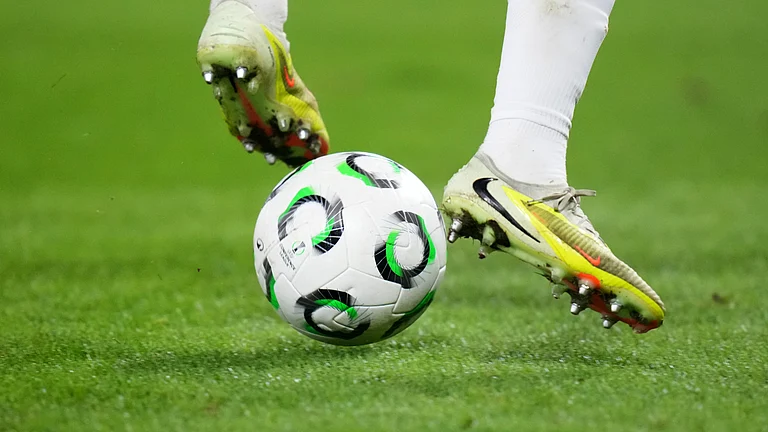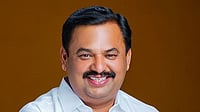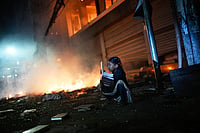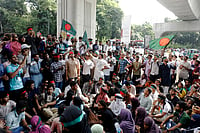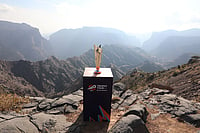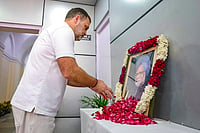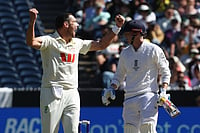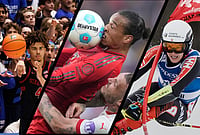Q. Thats a state visit, right?
Mr Lockhart: Yes.
Q. How about working visit?
Mr Lockhart: Whats the hand-sign for working visit? (Laughter.)
Q. Joe, Sunday night will be the last state dinner of PresidentClintons presidency to honor the Prime Minister of India - (laughter) - and one ofthe largest gatherings, 500 people are invited to the White House....
Mr Lockhart: And it may be the - (laughter.) One thing is that it may beor may not be the last official dinner. Of course its special. Its a veryimportant and special relationship. I think we have taken great strides, particularly inthe aftermath of our five-day visit to India. And this is a chance to build on that and Ithink itll be a wonderful evening for all 500 who get to attend and the many who getto watch it through the remarkable auspices of C-Span.
Q. Whats the menu?
Mr Lockhart: I think its food. (Laughter.)
- Excerpted from the transcript of a White House press briefing on September 14,demonstrating the US medias interest in Vajpayees visit
The leitmotif of Prime Minister Atal Behari Vajpayees US visit became apparent in his address to the US Congress when he brought Indias concerns on terrorism into sharp focus, yet again. He said: "There are forces outside our country that believe they can use terror to undo the territorial integrity of India. They wish to show that a multi-religious society cant exist. They pursue a task in which they are doomed to fail." And this was greeted with unqualified applause.
That, however, is only one way of telling the story. The other, perhaps, more complete way of putting it across would entail mentioning the fact that there were only 70-80 members of the Congress present when Vajpayee made his speech, less than one-third the Congress total strength. Some critics carped that the rest of the audience comprised interns and schoolchildren. One Indian official attributed the relatively poor attendance to the countrys consuming preoccupation with the presidential elections and its limited interest in India.
Indeed, the lack of US media interest in Vajpayees visit was palpable. For instance, The Washington Post did not even bother to list Vajpayees address in its daily listing of the activities in the US Congress. This has once again raised questions over the wisdom of the timing of the visit. Some contrasted his trip with that of Rajiv Gandhi in the eighties, when the latter was hosted at the Washington press club. Rajiv Gandhi had then come across as charming, energetic, articulate, youthful - and someone whom the US media loved.
But Vajpayee laboured on, regardless of his knees and the pain it was causing him. Delivering his speech sitting down, Vajpayee, though, used the occasion to put Asian security firmly on the Indo-US agenda. He said: "In this Congress you have often expressed concerns about the future contours of Asia. Will it be an Asia that will be at peace with itself? Or will it be a continent, where countries seek to redraw boundaries and settle claims - historical or imaginary - through force? We seek an Asia where power doesnt threaten stability and security. We dont want the domination of some to crowd out the space for others. We must create an Asia where cooperative rather than aggressive assertion of national self-interests defines behaviour among nations." Thus, naming neither Pakistan nor China, Vajpayee sought to define the template on which to build a new relationship with the US.
Senator Patrick Moynihan, who was once US ambassador to India, thought Vajpayees speech was "historic, unprecedented, and I do so much hope that events move as (the prime minister) so eloquently hoped they would." Even Republican Senator Sam Brownback thought that Vajpayees invitation to work with the US on a range of common issues were "very forward leaning... symbolising a new stage in Indo-US relations".
Some, though, thought that the speech lacked the zing Americans love. Says an Indian observer: "There was no reference to history, no reference to American culture and the style was bland, when compared to Clintons speech in our Parliament."
The 25-minute speech to the Congress, however, seemed to mark a shift from the earlier strident, anti-Pakistan tone Vajpayee had adopted in New York. South Asian specialist Stephen Cohen told Outlook: "I heard Vajpayees Congress speech, it appeared more tempered down since New York. And thats what makes it a qualified success. India has been lately emphasising on Indo-US relationship, because just attacking Pakistan is demeaning. It gets you down to the same level as the object of your attack."
Sources say it was foreign minister Jaswant Singh who impressed upon Vajpayee the merits of moderation in criticising Pakistan. His argument was that the prime minister, unlike Gen Pervez Musharraf, was not in the US to seek legitimacy.
But in what can be seen as a riposte to Musharraf, Vajpayee also told the Congress: "No country has faced as ferocious an attack of terrorist violence as India has over the past two decades. While 21,000 were killed by foreign-sponsored terrorists in Punjab alone, 16,000 have been killed in Jammu and Kashmir.... Indeed, in our neighbourhood - as in this 21st century - religious war has not just been fashioned into, it has been proclaimed to be an instrument of state policy."
Theres some thinking in the US that India cant shut out Pakistan from Kashmir indefinitely and that Delhi should undertake realistic forward movement to usher peace in the Valley. For instance, Teresita Schaffer of the Centre for Strategy and International Studies thinks Indias Kashmir policy is a little unrealistic. Says she: "India has not been able to achieve the results it hoped to get by isolating Pakistans military dictatorship."
Following his address to the US Congress, the prime minister attended a meeting of the Indian Caucus which comprises 120 members. Describing them as "friends in deed and friends in need", he said the Caucus was an "outstanding example of participatory democracy", serving as a bridge between the 1.5 million Indian American community and India.
The relatively hectic Washington leg of Vajpayees visit was preceded by a more relaxed schedule in New York. At the citys Waldorf Astoria, the historic recreation hotel, Vajpayee and his entourage rested in three days of relative peace before leaving for Washington. Nursing a very sore knee, the prime minister spent that time catching up with things he would find it difficult to do in Delhi. Like meeting actor Sanjay Dutt.
PERHAPS his poor health dampened his spirits and a usually witty man came across as dour and impatient. The most telling moment came when a delegation of Indian Muslim leaders, mainly from the Ajmer Sharif dargah in Rajasthan, who had attended the World Conference of Religion held earlier in the week, called upon the PM at the Waldorf. The interaction went as follows:
Delegation: We need to hold such meetings in India to promote communalamity and better understanding between communities."
Vajpayee nods his head.
Delegation: We fully support your Kashmir policy.
Vajpayee nods.
Delegation: We hail your Lahore initiative, unfortunately it was notreciprocated.
Vajpayee nods again.
Delegation: Is there any way we can help?
Vajpayee nods yet again.
In fact, the visitors anteroom in Vajpayees vip suite at Waldorf witnessed other such spectacles. A delegation of senior Sikh leaders called upon him last week, presented a saropa, praised his political initiatives, but got little other than unintelligent nods and stares.
At the hotel, the strong Indian delegation - son-in-law Ranjan Bhattacharya, ministers Jaswant Singh and Yashwant Sinha and Congress leader Najma Heptullah and the pmo staff headed by Brajesh Mishra - savoured the American culinary delights, but Vajpayee stuck to his chapati, dal, rice and liberal helpings of dessert.
It wasnt all fun and games in New York. The real pluses of the visit could subsequently show in economic relations between the two countries. At the first US-India business summit in New York, Vajpayee emphasised the fact that India was a good place to invest as it was among the fastest growing economies. "Let us accept a target of $5 billion of annual flow beginning next year and raise it to $15 billion over the next three years," he said. He announced the setting up of a strategic management group in the pmo where difficulties encountered by large investment projects will be speedily resolved. "The success stories do not circulate fast enough. Our failure proves infectious," he told American businessmen.
At the US Congress, too, the prime minister returned to the theme that Indian was a good place to invest in. He said, "Important sectors of the countrys infrastructure - power, insurance, banking, telecom - are being opened to private initiative, domestic and foreign. Trade barriers are being lowered."
Yashwant Sinha, in fact, told Outlook that the trip had achieved quite a bit and that Americans were now more keen to do business with India than ever before. Says Carter Booth, managing director of The Chase Manhattan Bank, Asia Pacific: "There is great excitement as India is emerging as a leading place to invest in. American businessmen are certainly interested."
Adds an Indian official: "A series of meetings are being held away from the media focus. After all, there are six Union secretaries from economic ministries in Washington today who are looking at outstanding issues like telecom, power and other core sectors."
Does it mean that Indo-US partnership could be turning a new leaf? Experts say that to expect anything dramatic would be ambitious, but the current aim is to engage the Americans in the realm of politics and business. "This does validate to some extent the Indian argument that major powers understand and respect the language of power," says Mohammed Ayub, a South Asian expert at the Michigan State University.
But for one solitary foray, it seemed Vajpayee was reluctant to step out of Waldorf Astoria. Till then, what Indian journalists were obsessed about were his health and the controversy over addressing the American wing of the vhp at Staten Island, a settlement largely comprising second-generation Indians and Asian immigrants. The theme here was Indian culture (read Hindutva). Sadhus like Acharya Dharmendra and Sadhu Vasvani reminded Indo-Americans that despite all their wealth, they have yet to set up a school for Indian children.
But all this was drowned in the din of controversy generated over his swayamsevak remark. The problem arose because he spoke extempore. But what was unusual was that the prime minister blamed the media for inaccurate reporting. He claimed, "I said that I had come to Staten Island as Indias pratham sevak (first servant). I also considered myself as a swayamsevak (volunteer) of India and her people and I shall remain so even after I cease to be prime minister." The PM said there was an attempt to link his remark to the Ayodhya issue, which found no mention in his speech. One view, though, has it that Vajpayee should have kept away from the vhp meet considering that he was in the US as prime minister of India.
Ultimately, it was the prime ministerial knee that grabbed the headlines. Perhaps the most significant development in New York was the announcement that orthopaedic surgeon Chitranjan S. Ranawat of the Centre for Total Joint Replacement, Lennox Hill Hospital, New York, would fly down to India to operate upon Vajpayees knee later. Sources say this will take place in October this year. (Incidentally, Dr Ranawat didnt get a job in Indore in the sixties due to rampant corruption and nepotism in the selection process and emigrated.)
What is now to be seen is the political fallout of the prime ministers knee problem.








